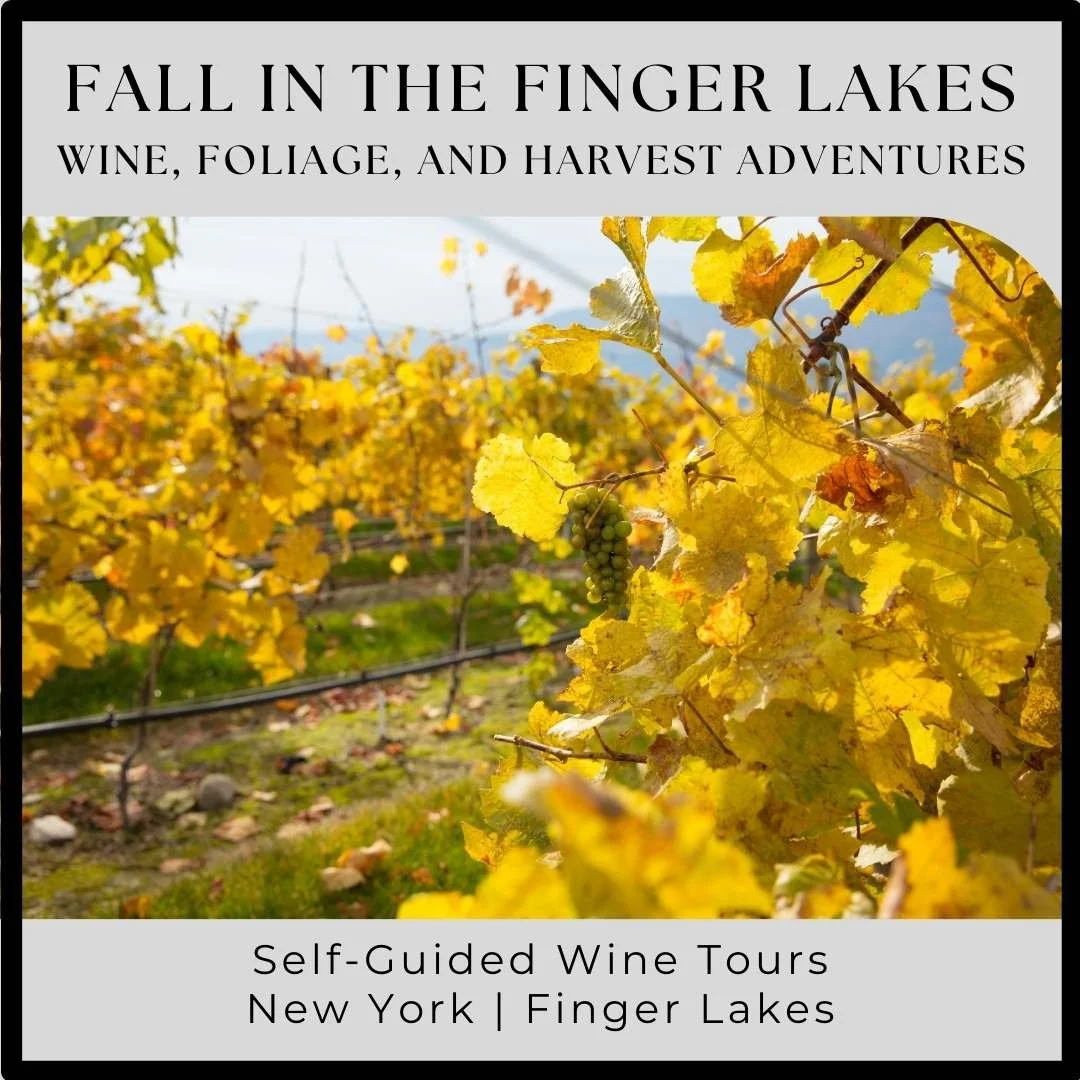Journey into Finger Lakes Terroir & Best Wine Vintages
Best Finger Lakes Wine Vintages Explained Through Three Lakes
New York | Finger Lakes
Updated: May 2025
When it comes to crafting distinctive and expressive wines, few regions rival the complexity and charm of the Finger Lakes terroir. Located among glacial lakes and rolling hills, the Finger Lakes wine region offers a rare balance of mineral-rich soils, varied elevations, and a cool climate—all essential ingredients for premium grape growing. This unique combination, along with the region’s numerous microclimates, helps explain why Finger Lakes wine continues to earn acclaim, vintage after vintage. Understanding how these natural forces shape wine is key to appreciating what makes the best Finger Lakes vintages stand out.
You Might Also Like These Finger Lakes Guides
Understanding The Finger Lakes Terroir and Microclimates
The Finger Lakes is a perfect balance of many factors that make it an ideal location for grape cultivation. The region provides the key elements for growing quality grapes: mineral rich soils, good drainage and a moderate climate. The region also offers diversity which means that many different types of grape varieties and wine styles can be produced in the area. It is up the grape growers and the wine makers to evaluate each vineyard site to determine what style will best serve the specific terroir.
Terroir, a French term, captures the diverse natural environmental factors that influence a wine's character. This encompasses the land's topography, soil composition, and overall climate, all contributing to the distinct flavors of wines. Additionally, terroir extends to smaller areas known as microclimates, referring to specific climate conditions within a smaller area of a wine region. These microclimates can narrow down to individual vineyards or even specific rows of vines within a vineyard.
Mineral rich soils: Diverse soil compositions in the Finger Lakes region inspire winemakers to experiment with various grape varieties from vitis vinifera, hybrids and native. Lower-elevation lakes, Seneca and Cayuga, feature chalky, high-lime soil, while the higher-altitude lake, Keuka have more acidic soil, influencing the types of grapes cultivated.
Hillsides and Moderate Temperatures: The steep hillsides and deep lakes not only provide ample drainage to vineyard sites but also create a moderating effect on temperatures. This dynamic interplay regulates airflow, minimizing humidity, preventing mildews, and ensuring optimal grape health in the cooler climate.
Seneca Lake: Microclimates at Play
Seneca Lake Overview: Seneca Lake, the biggest among the Finger Lakes, showcases special microclimates shaped by its depth, size and lower elevation. Thanks to the lake's consistent warmth, even in winter, it helps produce ripe fruit, leading to some of the best wines in the region. The deep waters of Seneca Lake, resistant to freezing, play a vital role in regulating temperatures. By holding and gradually releasing heat, the lake prevents drastic temperature swings, creating an ideal setting for growing grapes.
Atwater Vineyard’s Seneca Lake Banana Belt Vineyard overlooking Seneca Lake
Banana Belt Microclimate: The Seneca Lake "Banana Belt" on the southeastern shores of Seneca Lake, spanning from about Watkins Glen to Valois. It’s characterized by warmer temperatures, especially near the lake, steep hills and abundant sunlight, enjoys an extended growing season. This specific microclimate boosts the ripening of grapes, making it an ideal spot for nurturing red grape varieties such as Syrah, Pinot Noir, and Merlot. Renowned for hosting some of the finest vineyard locations in the entire Finger Lakes region, for wineries like Damiani Wine Cellars, Shalestone Vineyards, and Leidenfrost Vineyards, this area is celebrated for its optimal grape-growing conditions.
Sawmill Creek Vineyards: Situated within the Seneca Lake Banana Belt region of the Finger Lakes, Sawmill Creek Vineyards stands as one of the most renowned vineyard sites. Owned and operated by Eric Hazlitt, a sixth-generation Finger Lakes wine grape grower whose family farm dates back to 1852, the vineyard supplies grapes to over two dozen wineries. Among its clients are names such as Barnstormer Winery, Billsboro Winery, JR Dill Winery, Damiani Wine Cellars, Hector Wine Company, Dr. Konstantin Frank Winery, and Red Newt Cellars.
Sawmill Creek Vineyards cultivates a diverse range of grape varieties, including Cabernet Sauvignon, Cabernet Franc, Lemberger, Syrah, Merlot, Riesling, Chardonnay, Vidal Blanc, Sauvignon Blanc, Gewurztraminer, Albarino, Pinot Blanc, and Pinot Gris. The vineyard's dedication to quality is reflected in the numerous award-winning wines it produces. Notably, Billsboro Winery's 2013 Syrah, sourced from Sawmill Creek Vineyards, claimed the prestigious Governor's Cup at The New York Wine Classic.
Wines carrying the Sawmill Creek label are synonymous with exceptional quality, making them a must-try for wine enthusiasts exploring the Finger Lakes region. Additionally, Sawmill Creek Vineyards offers a unique opportunity for visitors to engage with its heritage by opening its doors to the public each July for cherry-picking in their orchards.
Featured Finger Lakes Wine Education
Cayuga Lake: A Temperate Haven
Cayuga Lake Overview: Cayuga Lake shares a lot of similarities to Seneca Lake. It is the second-largest Finger Lake, rarely freezes due to its depth. It sits at a lower elevation than the surrounding lakes. Its temperate climate, moderated by the lake, provides an ideal environment for winemaking. The vineyards planted on steep slopes facilitate air patterns, creating a microclimate that benefits grape cultivation.
Sheldrake Point's Estate Vineyard: Sheldrake Point's Estate vineyard commenced its plantings in 1997 and now covers 55 acres of vines, cultivating 10 grape varieties on-site, including Riesling, Gewurztraminer, Chardonnay, Pinot Gris, Muscat Ottonel, Cabernet Franc, Syrah, Gamay, Merlot, Pinot Noir, and Cabernet Sauvignon. Positioned on the west side of Cayuga Lake between two deep gorges, the vineyards slope eastward towards the lake's edge, reaching an upper elevation of 578 feet. Similar to Seneca Lake, the depth of Cayuga Lake moderates the vineyard's temperatures, providing benefits such as preventing early bud break and early fall frost. The soils of the Sheldrake Point Vineyard comprise a blend of gravelly loam, glacial clay, shale, limestone, and slate.
Patrician Verona Vineyard: Patrician Verona Vineyard, part of Hosmer Winery, and has supplied Riesling and Pinot Noir to Heart and Hands Wine Company. Established in 1972, it's one of Cayuga Lake's oldest vineyard sites, with nearly 70 acres of vines on its eastern-facing slopes. Recognized for sustainable viticulture, it received a National Conservation Stewardship Award for its commitment to conservation. Its North to South row layout optimizes sunlight exposure, while the lake's depth moderates temperatures. With silt loam and shale soil, it nurtures various grapes including; Riesling, Sauvignon Blanc, Pinot Gris, Chardonnay, Pinot Noir, Cabernet Franc, Lemberger, and several other native and hybrid varieties. Rieslings from this site feature tropical and citrusy aromatics, while Pinot Noirs offer earthy flavors.
Featured Finger Lakes Wine Travel Tips
Keuka Lake: Elegance in Coolness
Dr. Konstantin Frank Keuka Lake Vineyard - Photo by Stu Gallagher
Keuka Lake Overview: The vineyards on the elevated and steep slopes surrounding Keuka Lake contribute to the region's cooler climate. Keuka Lake is smaller and shallower compared to Seneca and Cayuga Lakes. During extremely cold winters, Keuka Lake may even freeze over. The higher elevation of both the lake and vineyards further contributes to this cooler environment. Despite being cooler compared to other lakes, Keuka Lake provides enough winter moderation. However, the elevated vineyards are more prone to earlier fall frosts than the regions around larger lakes. This unique setting fosters the production of wines with a distinctive mineral style and heightened acidity.
Old Vines of Dr. Konstantin Frank Winery: Established in 1958 on the steep slopes of Keuka Lake's western side, Dr. Konstantin Frank's vineyard is home to some of the oldest vines in the Finger Lakes, consistently yielding high-quality, award-winning wines. Old vines offer several winemaking advantages, including deeper root systems that access more nutrients, leading to complex flavors. Mature vines adapt to different climates, ensuring consistent quality, and produce smaller, structured berries ideal for high-quality wines, prioritizing quality over quantity.
Spanning 70 acres, the Keuka Lake vineyard cultivates 11 grape varieties, with some vines dating back to the late 1950s and early 1960s. Notably, Riesling, the oldest variety planted in 1958, stands out among others like Chardonnay, Rkatsiteli, Gewurztraminer, Pinot Gris, Pinot Noir, Pinot Meunier, Cabernet Franc, Merlot, Cabernet Sauvignon, and Amur.
Situated on east-facing slopes with elevations ranging from 950 ft to 1200 ft and shallow silt loam and shale soils, the vineyards offer unique terroir conditions. Despite Keuka Lake's smaller and shallower nature compared to Seneca Lake and Cayuga Lake, occasional freezing and cooler overall climates prevail. These conditions, coupled with the soil composition, result in high-acid wines with notable minerality. Additionally, the vineyard's terroir is ideal for crafting traditional method sparkling wines, utilizing Chardonnay, Pinot Noir, and Pinot Meunier grapes grown on-site.
The Finger Lakes region provides an ideal environment for grape cultivation, blending mineral-rich soils and a moderate climate. This diversity allows for the cultivation of various grape varieties and wine styles. Understanding terroir and microclimates becomes crucial, with unique features like Seneca Lake's microclimates, the "Banana Belt," and Keuka Lake's cooler climate. Each lake contributes distinct nuances, offering winemakers many factors to craft wines that celebrate the region's terroir in each vintage and varietal.
Featured Finger Lakes Self-Guided Wine Tours
Finger Lakes 2024 Vintage Report Summary
The 2024 growing season in the Finger Lakes began with an early bud break and was marked by record warmth, punctuated by just the right amount of rainfall. These nearly ideal conditions—warm days, cool nights, and minimal precipitation during harvest—allowed grapes to remain on the vine longer, encouraging full ripeness and the development of concentrated, complex flavors. According to the Finger Lakes Wine Alliance, winemakers and growers throughout the region are reporting wines that are aromatic, structured, and full of character.
Two of the Finger Lakes’ flagship varieties, Riesling and Cabernet Franc, particularly thrived this year. The excellent weather and extended growing season contributed to outstanding quality in both reds and whites. Notably, the 2024 season also brought the rare and exciting opportunity to produce both botrytis-affected dessert wines and ice wines in January and December—making it a nearly perfect year for producing wines across the stylistic spectrum.
Standout Varieties
Riesling in all its expressions—dry, off-dry, sweet, and dessert styles, including those influenced by botrytis and ice wine—shined in 2024. It was a remarkable year for showcasing the grape’s versatility.
Cabernet Franc displayed a wide range of character thanks to the long season and flexible harvest windows. This allowed winemakers to create everything from lighter, fresher styles to bold, concentrated reds.
Dessert Wines
A defining feature of the 2024 vintage was the return of botrytis cinerea (noble rot). This beneficial fungus requires a precise mix of cool, foggy mornings followed by dry, sunny afternoons—conditions met in specific microclimates throughout the region. This enabled producers to craft luxurious late-harvest and dessert wines, reminiscent of German Trockenbeerenauslese (TBA).
See these behind-the-scenes looks into botrytis wine production:
Weis Vineyards, Keuka Lake, processing botrytis-affected grapes on October 25, 2024: Watch here
Silver Thread Vineyards, Seneca Lake, harvesting botrytis Riesling on October 10, 2024: View post
Domaine Leseurre, Keuka Lake, showing off late-harvest botrytis grapes on November 14, 2024: See video
A Two-Part Ice Wine Harvest
The 2024 vintage was also exceptional for ice wine, featuring not just one, but two harvests under the same vintage year—an extremely rare occurrence in the Finger Lakes.
The first harvest took place in January 2024, technically making use of grapes from the 2023 growing season, but labeled as a 2024 vintage due to the harvest date.
The second harvest, unusually early, occurred in December 2024, offering the rare chance to compare two distinct ice wines from the same vintage year.
Highlights include:
Knapp Winery, Cayuga Lake, welcomes its inaugural ice wine, made from Vidal Blanc harvested in January 2024: View post
Weis Vineyard, Keuka Lake, capturing their December 2024 harvest under ideal frozen conditions: Watch here
Sheldrake Point Winery, Cayuga Lake, December 2024 harvest, their first ice wine since 2020: View post
2020 Finger Lakes Vintage: A Year of Excellence
Another recent year to explore is the 2020 vintage. The 2020 Finger Lakes vintage emerges as a flagship year, hailed by industry experts as possibly the greatest in living memory. It was a drought year, experiencing very little rainfall but proved to be instrumental in crafting fresh, lively whites and remarkable reds. Notably, the reds of 2020 stand as a benchmark for the region, boasting deep color, concentration, and captivating aromatics. The drought conditions during the year, while impacting yields with smaller berries due to heat stress, proved beneficial by lowering humidity and reducing disease pressures in the vineyards. Though some wineries faced challenges with smaller grape sizes affecting production, the overall consensus is that the 2020 vintage, despite reduced yields, produced wines of excellent quality, marked by concentrated fruit and a harmonious balance between acidity and sweetness. During wine tastings, if you come across any of the 2020 vintages, especially the red, give it a try.
Top Rated Finger Lakes Wine to Try Today
Best Finger Lakes Vintages - Election Year Connection
Best Finger Lakes Wine Vintage 2020
In the Finger Lakes, great wine seems to follow the rhythm of the ballot box. Every four years—like clockwork—presidential election seasons have aligned with some of the region’s most exceptional vintages. From the standout years of 2012, 2016, and 2020 to the near-perfect 2024 harvest, the pattern is undeniable: election years continue to deliver some of the Finger Lakes’ finest wines.
2012: Considered an exceptional year with favorable weather conditions, resulting in well-balanced and expressive wine
2014: Another strong vintage known for producing high-quality wines, particularly Rieslings, with good acidity and flavor.
2016: A vintage characterized by a warm and dry growing season, contributing to the production of vibrant and well-structured wines.
2017: Despite some challenges, including a late frost, this year produced wines with complexity and character, especially in the Riesling category.
2020: The 2020 vintage is one of the best in recent history, with excellent ripeness, balance, and freshness in both red and white wines.
2024: A near-perfect vintage marked by record warmth, ideal harvest weather, and an extended growing season, producing aromatic, structured wines across all styles—especially standout Rieslings, Cabernet Francs, and rare botrytis and ice wines.
* Summary of the recent vintage reports from the Finger Lakes Wine Alliance
Final Thoughts
From the temperature-regulating depths of Seneca Lake to the diverse soil compositions across vineyard slopes, the Finger Lakes terroir is a dynamic force behind the region's wine quality. These finely tuned Finger Lakes microclimates influence everything from grape ripeness to acidity, giving each wine a sense of place. As growers and winemakers continue to explore and respect these subtle differences, they’re producing some of the most compelling wines in New York and beyond. With each passing season, the best Finger Lakes vintages tell a story of land, climate, and craftsmanship—proving that the heart of Finger Lakes wine lies in its unique connection to nature.
















































































